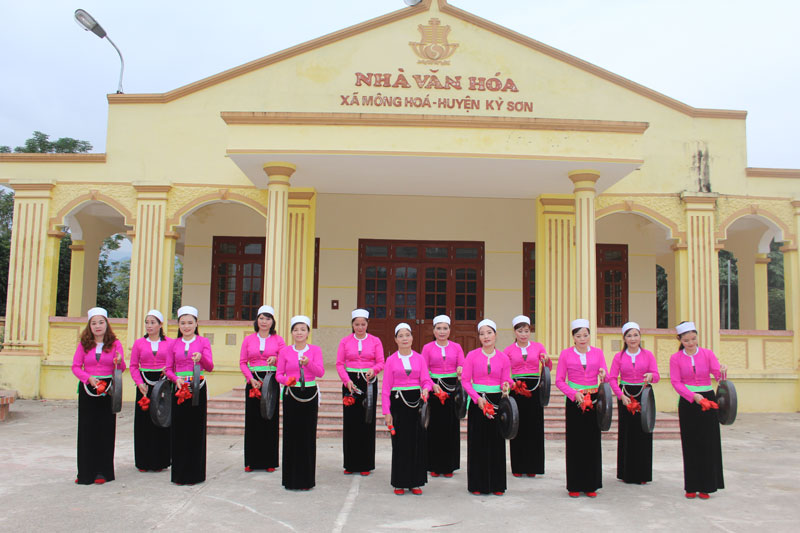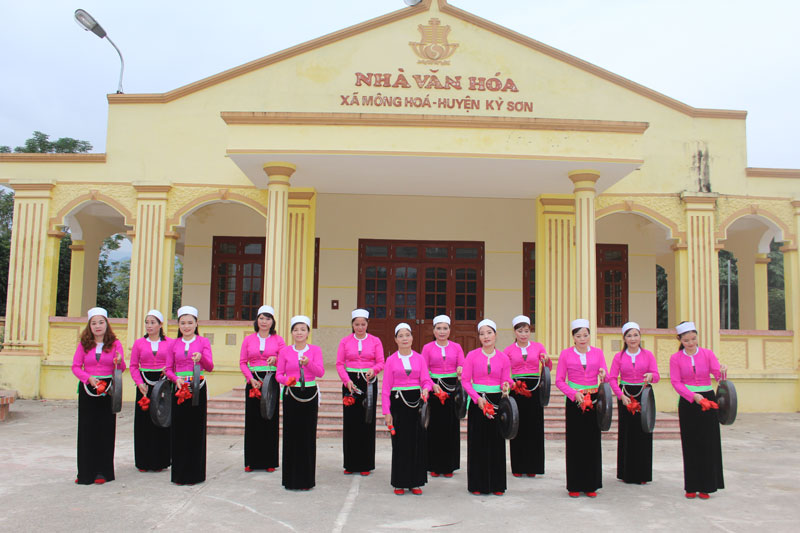
(HBO) – Many generations in Ky Son District’s communes always preserve and promote the outstanding cultural identities of the ethnic people. For them, Gong is not merely a musical instrument but has become a spiritual cultural value which is indispensible in community life.
The artists in Gong club of Du 6 village, Mong Hoa commune (Ky Son) enthusiastically practicing for their performances in the next special occasions and Tet holiday.
Visiting the culture center of Mong Hoa commune in the last days of the year, we met the artist Nguyen Thi Le Sinh who was guiding the members in the Gong club of Du 6 commune to practice for their performances in the upcoming special occasions. At the first glance, a few people can think that she is more than her age of 65. Her hands were so smooth and skillful with each gesture, instructing each member how to beat the Gong properly and how strong was the force needed for the resonant sound. She shared: The club of Du 6 village was established in 2010 with 12 main members, deriving from the passion of the people in the commune towards this kind of national musical instrument. The Gong resonance in each village has become familiar, close and connected to the soul and spirit in culture life of the people here.
On the traditional New Year’s Day, spring festivals, the happy days of the villages, hamlets, clans, cultural or artistic programs of Muong ethnic people here cannot lack the melodious and resonant sound of Gong.
Muong Ethnic people in Ky Son currently preserve their traditional typical culture identities, such as: Gong, Mo Muong ritual, Dum singing, etc. However, the preservation and promotion of the ethnic cultural values of Ky Son District are facing many challenges, which have been caused by the interference effect on the modern life. Therefore, a lot of traditional cultural identities are facing the risk of being lost gradually, and most of cultural values are word of mouth. For that situation, in the past years, in order to grasp thoroughly the people’s awareness about the policy "Culture is the spiritual foundation of the society” and to protect cultural beauty from losing by time, the actions of preservation and promotion of Muong ethnic cultural values is always being taken into consideration by Ky Son District.
The preservation of Gong culture is being exploited effectively. At present, in the whole district, there are 26 Gong clubs with more than 300 artists, mainly perform in special occasions, Tet holiday and important events of the district and the province. Since 2012 up to now, the district has opened many classes to teach Gongs for more than 200 artists in the area. Now, the district keeps 26 Gong sets and more than 500 gongs.
Ms. Dinh Thi Bich Dam, the Vice Head of Ky Son District Culture Board, said that: the district has held some activities like surveys, reviews and evaluation of the real Muong ethnic culture in the local villages and hamlets in order to have specific preservation plans. On special occasions, traditional Tet holiday, especially the Spring Festivals upcoming in the lunar January every year, the district organizes a lot of cultural and artistic activities to preserve folk music and dance of Muong ethnic people or organizes traditional folk games like throwing spindles, Danh Mang (throwing piece of stones), stick pushing and teeter, etc. Besides, the district focuses on propagandizing widely to people, especially the youth so that they can understand, preserve and promote the cultural identity of their ethnic minority.
With an increasingly vibrant and widespread emulation movement aimed at building cultured residential areas and cultured families, Yen Thuy District has been making steady progress toward improving both the material and spiritual well-being of its people, while fostering a civilized, prosperous, beautiful, and progressive community.
Once lacking recreational spaces and community facilities, Residential Group 2 in Quynh Lam Ward (Hoa Binh City) has recently received attention for the construction of a new, spacious, and fully equipped cultural house. The project followed the model of state support combined with public contributions in both labor and funding.
The "All people unite to build cultural life" movement, which has been effectively integrated with Kim Boi district’s socio-economic development goals, is fostering a lively spirit of emulation across local residential areas, hamlets, villages, public agencies, and enterprises. In addition, through the initiative, traditional cultural values are being preserved and promoted, while community solidarity and mutual support in poverty reduction and economic development are being strengthened.
A working delegation of the Hoa Binh provincial People’s Committee led by its Permanent Vice Chairman Nguyen Van Toan on June 11 inspected the progress of a project to build the Mo Muong Cultural Heritage Conservation Space linked to tourism services in Hop Phong commune, Cao Phong district.
Born and growing in the heroic land of Muong Dong, Dinh Thi Kieu Dung, a resident in Bo town of Kim Boi district, in her childhood was nurtured by the sweet lullabies of her grandmother and mother. These melodies deeply imprinted on her soul, becoming an inseparable part of her love for her ethnic group's culture. For over 20 years, this love for her hometown has driven Dung to research, collect, and pass down the cultural values of the Muong people to future generations.
In the final days of May, the Ethnic Art Troupe of Hoa Binh Province organized performances to serve the people in remote, mountainous, and particularly disadvantaged areas within the province. These were not just ordinary artistic shows, but they were the meaningful journeys aimed at spreading cultural values, enhancing the spiritual life of the people and contributing to the preservation of ethnic minority cultural identities.



